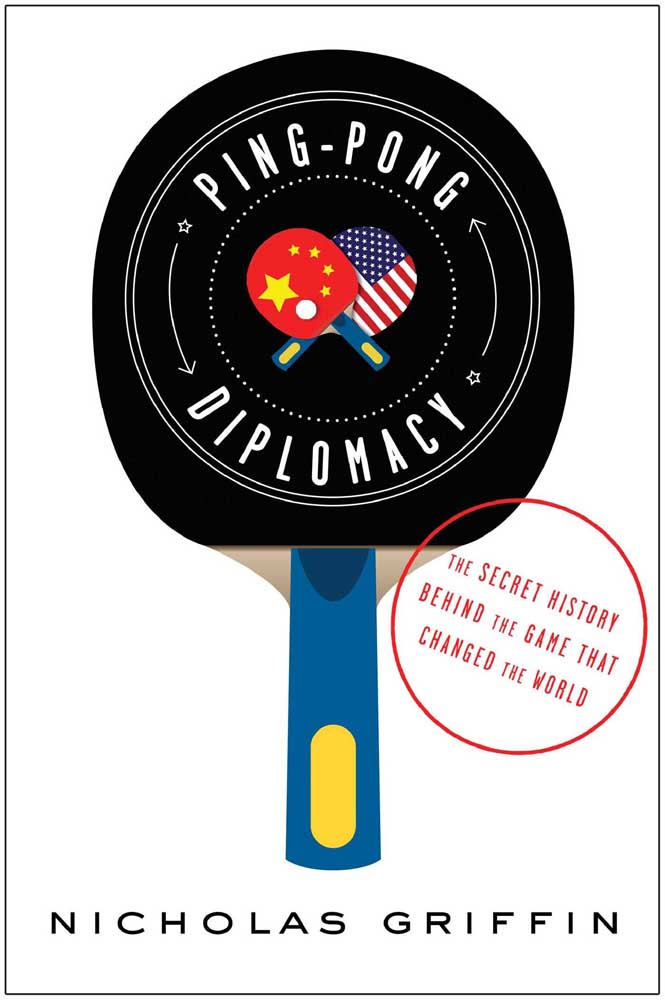’Ping-Pong Diplomacy’: table for 2 (countries)
Published 12:00 am Sunday, January 5, 2014

- ’Ping-Pong Diplomacy’: table for 2 (countries)
‘Ping-Pong Diplomacy: The Secret History Behind the Game That Changed the World’by Nicholas Griffin (336 pgs., Scribner, $26)
When the game of table tennis became the focus of diplomatic efforts to defuse Cold War tensions between the United States and China, no detail was too small to warrant scrutiny. As Nicholas Griffin demonstrates, in a book filled with well-chosen examples, the Chinese team visiting Colonial Williamsburg in 1972 was comfortable eating apple pie and singing “Home on the Range.” But “Row, Row, Row Your Boat” was dicier: The line “life is but a dream” was politically incompatible with the teachings of Chairman Mao. Thanks to some fancy footwork on the part of a translator, the line turned into “life is full of steam.”
The team was en route from Virginia to Washington to meet President Richard Nixon, who had ordered a heavy air assault on the port of Haiphong in North Vietnam, China’s ally. One purpose of Ping-Pong diplomacy, as it came to be known, was its way of spreading good will and distracting both nations from such things.
As Griffin explains, the idea of Ping-Pong as a political tool can be traced back to one English-born Soviet spy with a passion for the game. Ivor Montagu was born in 1904, a very bad year in Ping-Pong history. The game had been enough of a fad to inspire awful poems (“Pingpongitis” is quoted here) and silly alternative names, among them whiff-whaff and gossima. But the fad “burst like a soap bubble into nothingness” that year, and that wasn’t the worst of it. At the start of the Russo-Japanese War, according to Griffin, two Russian ships were crippled by Japanese forces because their crews were distracted: “Apparently the Ping-Pong nets were up, all taut and ready: It was only the torpedo nets that had been forgotten.”
The first part of “Ping-Pong Diplomacy” describes how Montagu organized and raised the profile of table tennis (which was what the game now had to be called, since “Ping-Pong” was trademarked). But he was a man of many interests, and his others included film production and Stalinism. Montagu was sufficiently multifaceted to baffle MI5 during much of World War II, and the war itself had an ancillary effect of spreading the popularity of table tennis. The Red Cross brought it to prisoner-of-war camps to offset monumental boredom.
The book describes Montagu’s reasoning that the game might have a future in Asia. In 1935, it was the 12th most popular athletic activity in China, behind jumping rope and home construction. But with Mao’s rise came an emphasis on physical culture as well as physical labor, and there could be no better game for an airless factory setting. Chinese officials were also intrigued by the way Ichiro Ogimura, known as Ogi, became a Japanese good will ambassador in England despite lingering postwar bitterness, by sheer dint of his prowess and sportsmanship. His 1954 trip to England was a real coup, according to the Japanese news media, “much to the astonishment of those who still think that Japan’s national sports are cherry-blossom viewing and hara-kiri.”
As China’s agricultural policies (defended by Montagu, one of many who chose to override reason for the sake of ideology) led to famine, the idea of a triumphant Ping-Pong team began to seem ever more attractive. Top athletes were given star treatment, even while huge numbers of their countrymen were starving. As Griffin explains, they may have sensed where this would lead but were too dazzled by the sudden sense of privilege. “The new life was glorious,” one player said. But when Mao’s Great Leap Forward was followed by the Cultural Revolution, these players would pay for their privileges.
“Ping-Pong Diplomacy” builds up to the events of 1971, when a U.S. team was unexpectedly invited to visit China to participate in a table tennis competition. The book gives considerable credit to Nixon, Secretary of State Henry Kissinger and Bill Cunningham — a careful China-watcher at the U.S. Embassy in Tokyo who made the quick call that the team’s visit would not violate American foreign policy — for taking advantage of an unforeseen opportunity. Back-channel talks between the two countries had long been underway, with the status of Taiwan a particular sticking point. But the highly publicized visit of these unlikely U.S. emissaries may have accomplished more than years of solemn talks.
Among the many quirks that make Griffin’s account so interesting is the culture clash that ensued — not between the two teams, but within the group of Americans themselves. After all, this was 1971. Glenn Cowan, the group’s heat-seeking hippie, dressed for a visit to Woodstock and let no occasion for self-promotion go unexploited. He was also quite open about his marijuana use, to the point of oh-wowing about the chickens he met at a Chinese commune. (“They were yellow and really fascinating. You don’t see them at zoos. And they were right up close to me.”)
Also involved in the same trip were authority figures aghast at Cowan’s antics and a fellow player, John Tannehill, the stern ideologue to Cowan’s show-off. Cowan’s extremely casual approach to chatting with Zhou Enlai is the best-known part of the Ping-Pong diplomacy story.
But in addition to presenting a broad diplomatic tableau and fascinating personal histories, Griffin is careful to weigh the consequences of what his book describes. Glenn Cowan’s story is ultimately a bleak one, and Griffin finds a through line connecting those consequences to Ivor Montagu’s original ambitions. “Montagu built Ping-Pong for the state,” he says, “not the individual.”






